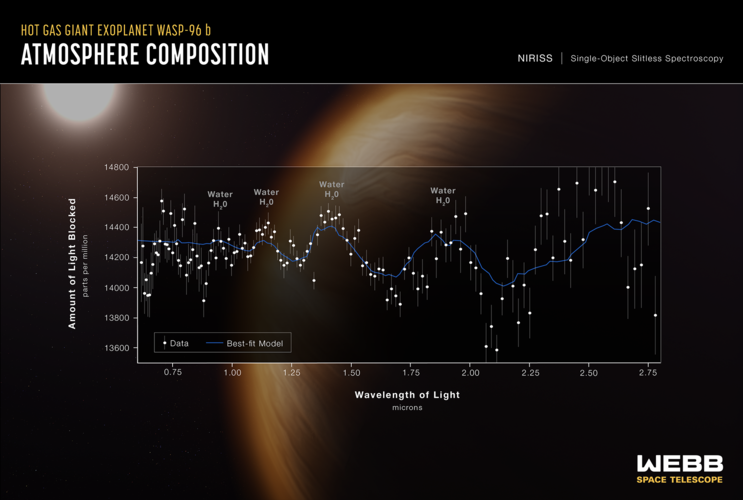
The spectrum of WASP-96 b captured by NIRISS is not only the most detailed near-infrared transmission spectrum of an exoplanet atmosphere captured to date, but it also covers a remarkably wide range of wavelengths, including visible red light and a portion of the spectrum that has not previously been accessible from other telescopes (wavelengths longer than 1.6 microns). This part of the spectrum is particularly sensitive to water as well as other key molecules like oxygen, methane, and carbon dioxide, which are not immediately obvious in the WASP-96 b spectrum but which should be detectable in other exoplanets planned for observation by Webb.
Researchers will be able to use the spectrum to measure the amount of water vapour in the atmosphere, constrain the abundance of various elements like carbon and oxygen, and estimate the temperature of the atmosphere with depth. They can then use this information to make inferences about the overall make-up of the planet, as well as how, when, and where it formed. The blue line on the graph is a best-fit model that takes into account the data, the known properties of WASP-96 b and its star (e.g., size, mass, temperature), and assumed characteristics of the atmosphere.
The exceptional detail and clarity of these measurements is possible because of Webb’s state-of-the-art design. Its 6.5-metre gold-coated mirror collects infrared light efficiently. Its precision spectrographs spread light out into rainbows of thousands of infrared colours. And its sensitive infrared detectors measure extremely subtle differences in brightness. NIRISS is able to detect colour differences of only about one thousandth of a micron (the difference between green and yellow is about 50 microns), and differences in the brightness between those colours of a few hundred parts per million.
In addition, Webb’s extreme stability and its orbital location around Lagrange Point 2 roughly 1.5 million kilometres away from the contaminating effects of Earth’s atmosphere makes for an uninterrupted view and clean data that can be analysed relatively quickly.
The extraordinarily detailed spectrum – made by simultaneously analysing 280 individual spectra captured over the observation – provides just a hint of what Webb has in store for exoplanet research. Over the coming year, researchers will use spectroscopy to analyse the surfaces and atmospheres of several dozen exoplanets, from small rocky planets to gas- and ice-rich giants. Nearly one-quarter of Webb’s Cycle 1 observation time is allocated to studying exoplanets and the materials that form them.
This NIRISS observation demonstrates that Webb has the power to characterise the atmospheres of exoplanets – including those of potentially habitable planets – in exquisite detail.



